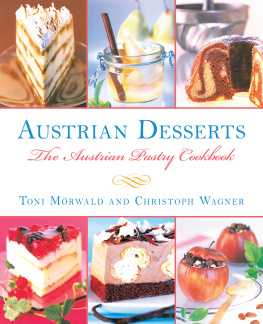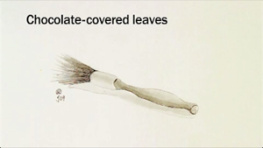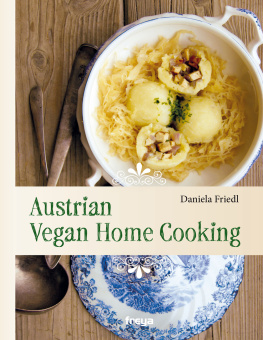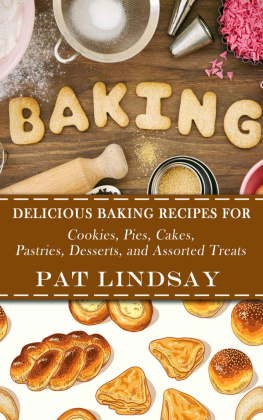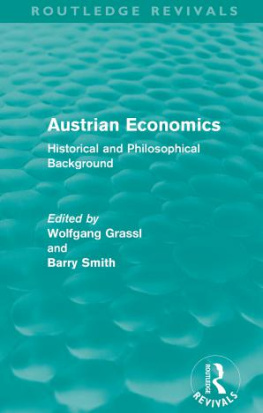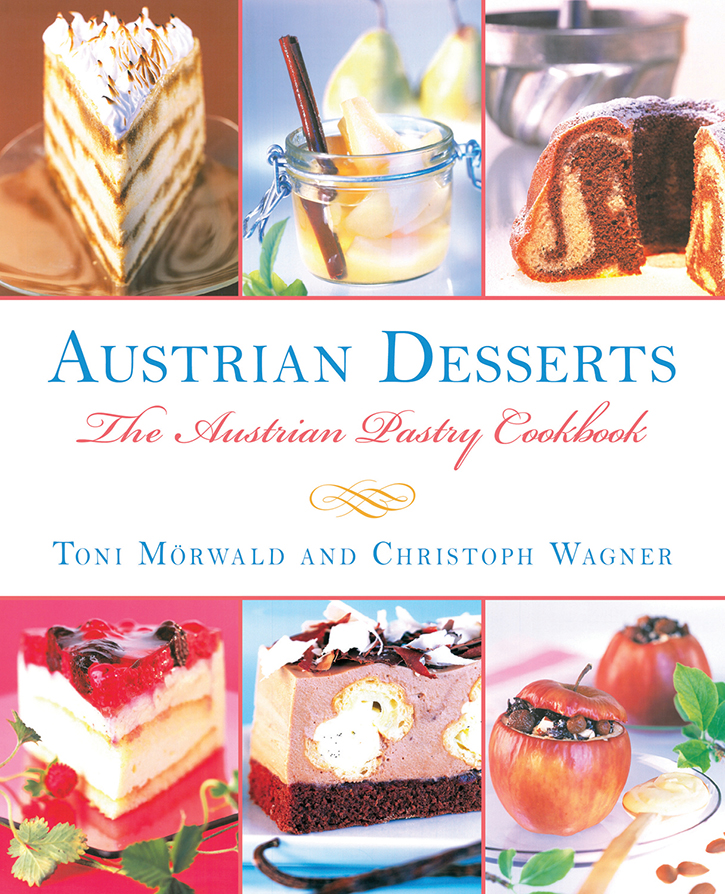
Austrian
DESSERTS
Toni Mrwald
Christoph Wagner
Austrian
DESSERTS
OVER 400 CAKES, PASTRIES,
STRUDELS, TORTES, AND CANDIES
In Cooperation with Martin Weiler
Photography by Ulrike Kb
Translation by Tobi Haberstroh

SKYHORSE PUBLISHING
Note
The given measurements will make four servings, unless otherwise noted.
Tarts, cakes, cookies, and confections can be portioned as desired.
The given measurements of flour refer to fine white pastry flour unless otherwise specified.
Recipe information:
Toni Mrward, Inn & Restaurant Zur Traube
Kleine Zeile 1317
A-3483 Feuersbrunn
AUSTRIA
Phone: 011-43-2738-2298-0; Fax: 011-43-2738-2298-60
toni@moerwald.at
www.moerwald.at
Bibliographic Information of The German Library
The German Library catalogued this publication in the
German National Bibliography; detailed bibliographic data
can be found on the internet at http://dnb.ddb.de
Copyright 2013 by Toni Mrwald and Christoph Wagner
2010 Residenz Verlag
im Niedersterreichischen Pressehaus
Druck- und Verlagsgesellschaft mbH
St. PltenSalzburg
All Rights Reserved. No part of this book may be reproduced in any manner without the express written consent of the publisher, except in the case of brief excerpts in critical reviews or articles. All inquiries should be addressed to Skyhorse Publishing, 307 West 36th Street, 11th Floor, New York, NY 10018.
Skyhorse Publishing books may be purchased in bulk at special discounts for sales promotion, corporate gifts, fund-raising, or educational purposes. Special Department, Skyhorse Publishing, 307 West 36th Street, 11th Floor, New York, NY 10018 or info@skyhorsepublishing.com.
Skyhorse and Skyhorse Publishing are registered trademarks of Skyhorse
Publishing, Inc., a Delaware corporation.
www.skyhorsepublishing.com
10 9 8 7 6 5 4 3 2 1
Library of Congress Cataloging-in-Publication Data is available on file.
ISBN: 978-1-61608-434-9
Printed in China
Contents
Foreword
Dear Readers,
Austria has always been a country where the heavens are filled with sweet temptations. An Austrian kitchen without sweet cooking would be completely unthinkable. Sometimes you get the impression that the meat dishes in Austria were only invented to lengthen the anticipation for dessert.
But actually, dessert is the greatest challenge for every cook, whether amateur or pro. Anyone who has ever hosted dinner knows dessert makes a meal successful.
This volume is concerned with making sure that this sweet climax succeeds every time. It is a fundamental cookbook for creating up-to-date baked goods and desserts. Up-to-date means first and foremost that we have tried to cater to modern dietary habits and, wherever possible, to use lots of fruit, soft dough, and light and airy creams. In a special chapter, we offer you a little basics course on whole foods baking according to the newest findings in nutritional physiology.
That admittedly does not change the fact that the words sweet and sinful are closely connected when it comes to baked goods. A sweet kitchen without sugar, chocolate, puff pastry, strudel, pancakes, whipped cream, brittle, marzipan, and all the other delectable seductions would miss the point, plain and simple.
Nevertheless, true enjoyment lies in moderation. For this reason, we have also placed particular importance on portion size so that the calorie-rich sweets do not leave behind an unnecessary feeling of being too stuffed or heavy. In this way, Austrian Desserts differs from older Austrian baked goods cookbooks, which were designed more for the needs of a hardworking rural population than for our modern urban hedonism.
Of course no one will stop anyone who still really wants to sin from simply having double the amount. Some of the following five hundred or so desserts are made with cake, cream, ice cream, fruit sauce, and similar ingredients. Of course, all of these components can be prepared separately or combined differently. That, too, separates the modern from the traditional Austrian kitchen: Here, there are no limits on fantasy and creativity.
On the following pages, we want not only to offer you authentic recipes, but also share all kinds of facts about the historical background of the sweet Austrian kitchen. And if you happen to be on a diet currently, you can use this dessert cookbook simply as a culinary reader, even just in anticipation of later sweet indulgences.
Austrian Dessert does not forget good old tradition, but is also a fundamental dessert cookbook that is tailored to the needs of a new generation who do not think of themselves as having a sweet tooth, but who simply want to have sweet dreams without regret. This book is the handbook for sweet dreams, and we dedicate it to you personally!
With sweet greetings,

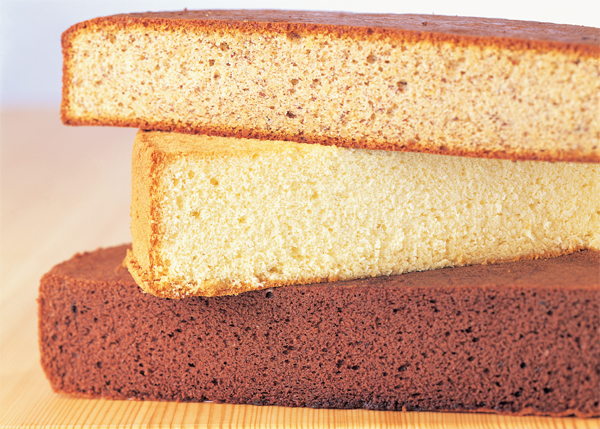
Basics of the Sweet Austrian Kitchen
B ASIC D OUGHS , B ATTERS, AND G LAZES
BASIC DOUGH
The word dough comes from kneading, which says the most important thing about its creation. The basic ingredient is always a grain that has been ground and mixed with liquid, fat, eggs, nuts, sugar, and flavoring and finally baked. Most doughs are also suitable for freezing.
As the Pastry Turns
The invention of puff pastry is the stuff of legends. It is entirely possible that it was Viennese bakers who first got the idea to roll out butter on water-based dough to make it airier. Presumably this technique was brought north by Viennese journeymen and Danish pastry developed from leavened flaky dough in Denmark. It is not a coincidence that the otherwise thoroughly patriotic French call pastries made of this dough Viennoiserie even today. Meanwhile in France, the expression millefeuille, which means 1,000 leaves, was invented for puff pastry or flaky pastry. That is admittedly one of the many little exaggerations that appear so often in the history of Grande Cuisine. In truth, a properly made puff pastry has more than 144 layerswhich is still enough for it to be very flaky due to the trapped air and the water content. The important process of rolling out and folding the dough many times is known to pastry chefs as turning. Traditionally, you need four turns for the puff pastry to turn out perfect.
B ASIC D OUGH FOR T ARTS
Cream the butter with the granulated sugar. Add the lemon zest and salt and then the eggs. Incorporate the flour and cool the dough for 1 hour in the refrigerator, covered. Preheat the oven to 375 F (190 C). On a floured work surface, roll the dough out to the proper size and line a buttered springform with it. Cover with parchment paper and dried lentils or peas. Bake for 1215 minutes. After baking, remove the parchment paper and lentils or peas and use the tart base as you wish.
Bake Time: 1215 minutes
Bake Temperature:
Next page
